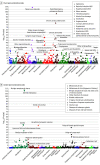Association of Telomere Length With Risk of Disease and Mortality
- PMID: 35040871
- PMCID: PMC8767489
- DOI: 10.1001/jamainternmed.2021.7804
Association of Telomere Length With Risk of Disease and Mortality
Abstract
Importance: Telomeres protect DNA from damage. Because they shorten with each mitotic cycle, leukocyte telomere length (LTL) serves as a mitotic clock. Reduced LTL has been associated with multiple human disorders.
Objective: To determine the association between LTL and overall as well as disease-specific mortality and morbidity.
Design, setting, and participants: This multicenter, community-based cohort study conducted from March 2006 to December 2010 included longitudinal follow-up (mean [SD], 12 [2] years) for 472 432 English participants from the United Kingdom Biobank (UK Biobank) and analyzed morbidity and mortality. The data were analyzed in 2021.
Main outcomes and measures: Hazard ratios (HRs) and odds ratios for mortality and morbidity associated with a standard deviation change in LTL, adjusted for age, sex, body mass index (calculated as weight in kilograms divided by height in meters squared), and ethnicity.
Results: This study included a total of 472 432 English participants, of whom 54% were women (mean age, 57 years). Reduced LTL was associated with increased overall (HR, 1.08; 95% CI, 1.07-1.09), cardiovascular (HR, 1.09; 95% CI, 1.06-1.12), respiratory (HR, 1.40; 95% CI, 1.34-1.45), digestive (HR, 1.26; 95% CI, 1.19-1.33), musculoskeletal (HR, 1.51; 95% CI, 1.35-1.92), and COVID-19 (HR, 1.15; 95% CI, 1.07-1.23) mortality, but not cancer-related mortality. A total of 214 disorders were significantly overrepresented and 37 underrepresented in participants with shorter LTL. Respiratory (11%), digestive/liver-related (14%), circulatory (18%), and musculoskeletal conditions (6%), together with infections (5%), accounted for most positive associations, whereas (benign) neoplasms and endocrinologic/metabolic disorders were the most underrepresented entities. Malignant tumors, esophageal cancer, and lymphoid and myeloid leukemia were significantly more common in participants with shorter LTL, whereas brain cancer and melanoma were less prevalent. While smoking and alcohol consumption were associated with shorter LTL, additional adjustment for both factors, as well as cognitive function/major comorbid conditions, did not significantly alter the results.
Conclusions and relevance: This cohort study found that shorter LTL was associated with a small risk increase of overall mortality, but a higher risk of mortality was associated with specific organs and diseases.
Conflict of interest statement
Figures





Comment in
-
Interpreting Geroscience-Guided Biomarker Studies.JAMA Intern Med. 2022 Mar 1;182(3):300-302. doi: 10.1001/jamainternmed.2021.7812. JAMA Intern Med. 2022. PMID: 35040910 Free PMC article. No abstract available.
References
-
- Weischer M, Bojesen SE, Nordestgaard BG. Telomere shortening unrelated to smoking, body weight, physical activity, and alcohol intake: 4,576 general population individuals with repeat measurements 10 years apart. PLoS Genet. 2014;10(3):e1004191. doi: 10.1371/journal.pgen.1004191 - DOI - PMC - PubMed
Publication types
MeSH terms
Grants and funding
LinkOut - more resources
Full Text Sources
Medical

